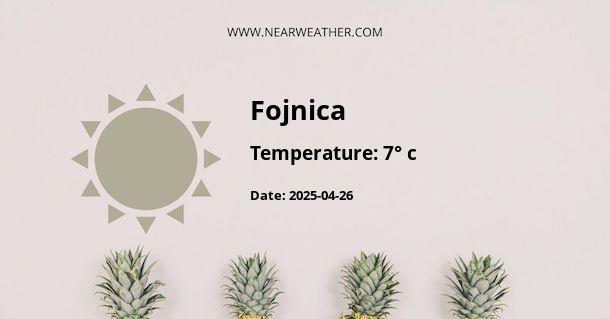Exploring the Climate and Weather of Fojnica, Bosnia and Herzegovina
Fojnica, a small town nestled in the heart of Bosnia and Herzegovina, boasts a climate that encapsulates the transition between Mediterranean and continental types. Understanding Fojnica's climate and weather patterns requires an exploration of its geographical location, historical weather data, and the influences of larger climatic systems that shape its unique weather landscape year-round.
Geographical Influence on Fojnica's Weather
Fojnica lies in the mountainous region of central Bosnia, which exerts a significant impact on its climate. The topography, with surrounding highlands, creates a moderating effect on temperatures, leading to cooler summers and colder winters compared to regions at lower elevations. This orographic influence further affects precipitation patterns, with Fojnica receiving ample rainfall throughout the year, often in the form of snow during the winter months.
Temperature Overview
The average temperature in Fojnica exhibits a substantial range throughout the year. Winters are characterized by cold conditions, with January temperatures averaging around 0°C (32°F). Contrastingly, July marks the peak of summer warmth, with average temperatures soaring to approximately 20°C (68°F). The transitional seasons, spring and autumn, provide a pleasant middle ground with mild temperatures and changing foliage.
Precipitation Patterns
Precipitation in Fojnica is distributed fairly evenly across the year, although May to November can be described as a slightly wetter period. The town experiences an annual average rainfall of around 1000 mm (39 inches), with the spring months occasionally bringing about thunderstorms that are both a spectacle and a vital contributor to the area's water resources.
Seasonal Weather Analysis
- Spring: The season is marked by a gradual increase in temperatures and a notable uptick in precipitation. Late frost can occur, with flora beginning to bloom as the landscape revitalizes after the winter months.
- Summer: Summer days are warm but seldom excessively hot, making Fojnica a pleasant escape from the sweltering heat found in other parts. However, this is also a period prone to sporadic showers and thunderstorms, particularly in the afternoons.
- Autumn: Featuring a gradual cooldown with picturesque autumnal colors, the weather remains relatively stable but becomes increasingly unpredictable as winter approaches. Rainfall is frequent, aiding in the preparation of the ground for the upcoming winter.
- Winter: Winters in Fojnica are brisk and snowy, with snow cover persisting for several weeks, if not months. Snow-related activities become a common sight, with temperature inversions sometimes leading to cooler temperatures in the valley below.
Climate Data and Statistics
| Month | Avg. High Temp. (°C) | Avg. Low Temp. (°C) | Avg. Precipitation (mm) |
|---|---|---|---|
| January | 2 | -3 | 70 |
| February | 5 | -1 | 65 |
| March | 9 | 1 | 70 |
| April | 13 | 5 | 75 |
| May | 18 | 9 | 85 |
| June | 21 | 12 | 90 |
| July | 24 | 14 | 80 |
| August | 23 | 13 | 80 |
| September | 20 | 10 | 85 |
| October | 15 | 6 | 80 |
| November | 9 | 2 | 85 |
| December | 3 | -1 | 75 |
Wind and Atmospheric Conditions
Winds in the Fojnica region tend to be mild to moderate, commonly originating from the northwest. The presence of mountains can lead to localized wind patterns that differ significantly from generalized regional trends. In winter, colder air from the surrounding peaks can funnel into the valley, while summer afternoons may experience upslope breezes as the land surface heats up.
Extreme Weather and Climate Events
Fojnica, like many other regions around the globe, is not immune to extreme weather events. Although relatively rare, severe thunderstorms and heavy snowfall can occur, disrupting daily life and posing challenges to infrastructure. Climate change influences are an increasing concern, with potential implications for both temperature and precipitation extremes.
Human Impact on Local Climate
The local climate of Fojnica is also subject to anthropogenic influences. Urban development, deforestation, and pollution contribute to microclimatic changes, which may be reflected in slight alterations to temperature and precipitation patterns over time. Environmental efforts within the region aim to monitor and mitigate these impacts, preserving the natural balance of Fojnica's weather systems.
Tourism and Weather Considerations
Visitors to Fojnica are often drawn by the allure of its natural beauty, thermal springs, and cultural heritage. The optimal times for tourism largely depend on the desired activities. Spring and summer offer opportunities for hiking and exploring the verdant countryside, while winter appeals to those interested in winter sports and enjoying the picturesque snow-covered vistas.
Preparing for Weather in Fojnica
When planning a visit or conducting activities in Fojnica, it is essential to prepare for the expected weather conditions. Clothing should be adaptable to the season, with warm layers necessary for winter and breathable fabrics for summer. Always have rain gear on hand due to the potential for precipitation year-round.
Understanding the detailed climate and weather patterns of Fojnica allows for a better appreciation of this region's dynamic and enchanting atmosphere. Its weather is as varied and rich as its landscape and culture, offering an experience that changes with each season.
A - Fojnica's Latitude is 43.962502 & Longitude is 17.898331.
A - Weather in Fojnica is 7° today.
A - Climate Conditions in Fojnica shows overcast clouds today.
A - Humidity in Fojnica is 97% today.
A - Wind speed in Fojnica is 4.18 km/h, flowing at 351° wind direction. today.
